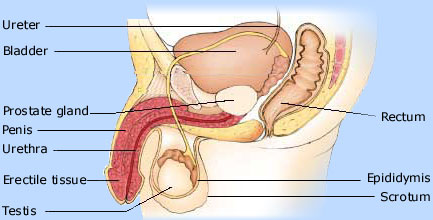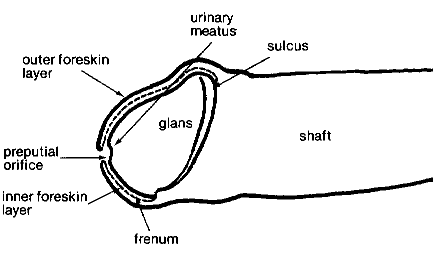|
Penile
Cancer
Cancer of the penis
occurs when
malignant
cells develop in the skin or tissue of the
penis. Cancer of the penis is very rare, but it is still very important to
be aware of the signs and symptoms. If penile cancer is detected early,
then the chances of a complete recovery are very good. Penile cancer can
develop anywhere on the penis, but most develop under the foreskin, in men
who have not been
circumcised or on the glans. the
penis. Cancer of the penis is very rare, but it is still very important to
be aware of the signs and symptoms. If penile cancer is detected early,
then the chances of a complete recovery are very good. Penile cancer can
develop anywhere on the penis, but most develop under the foreskin, in men
who have not been
circumcised or on the glans.
The
penis is the external male
genital organ. Inside the penis is the urethra,
the tube through which urine and
semen exit the body. The head of the penis is
called the glans and at birth the glans is covered by a loose piece of
skin, known as the
foreskin.
Cancer of the penis
Cancer of the penis, a rare kind of cancer, is
a disease in which cells are found on the skin and in the tissues of the penis.

Men who are not circumcised at birth may have
a higher risk for getting cancer of the penis. A circumcision is an operation in
which the doctor takes away part or all of the foreskin from the penis. The
foreskin is the skin which covers the tip of the penis. A circumcision is done
on many baby boys before they go home from the hospital.
A doctor should be seen if there are any of
the following problems: growths or sores on the penis, any unusual liquid coming
from the penis (abnormal discharge), or bleeding. If there are symptoms of cancer, the doctor
will examine the penis and feel for any lumps. If the penis doesnít look normal
or if the doctor feels any lumps, a small sample of tissue (called a biopsy)
will be cut from the penis and looked at under a microscope to see if there are
any cancer cells.
The chance of recovery and choice of treatment
depend on the stage of the cancer (whether it is just in the penis or has spread
to other places), and the patientís general state of health.
Stages of cancer of the penis
Once cancer of the penis is found, more tests
will be done to find out if the cancer has spread from the penis to other parts
of the body (staging). A doctor needs to know the stage of the disease to plan
treatment. The following stages are used for cancer of the penis:
Stage I
Cancer cells are found only on the surface of
the glans (the head of the penis) and on the foreskin (the loose skin that
covers the head of the penis).
Stage II
Cancer cells are found in the deeper tissues
of the glans and have spread to the shaft of the penis (the long, slender
cylinders of tissue inside the penis that contain spongy tissue and expand to
produce erections).
Stage III
Cancer cells are found in the penis and have
spread to nearby lymph nodes in the groin. (Lymph nodes are small bean-shaped
structures that are found throughout the body; they produce and store
infection-fighting cells).
Stage IV
Cancer cells are found throughout the penis
and the lymph nodes in the groin and/or have spread to other parts of the body.
Recurrent
Recurrent disease means that the cancer has
come back (recurred) after it has been treated. It may come back in the same
area or in another place.
How cancer of the penis is treated
There are treatments for all patients with
cancer of the penis. Four kinds of treatment are used:
- Surgery (taking out the cancer
in an operation)
- Radiation therapy (using
high-dose x-rays or other high-energy rays to kill cancer cells and shrink
tumours)
- Chemotherapy (using drugs to
kill the cancer cells)
- Biological therapy (using the
immune system to fight cancer)
Surgery is the most common treatment of all
stages of cancer of the penis. A doctor may take out the cancer using one of the
following operations:
- Wide local excision takes out
only the cancer and some normal tissue on either side.
- Microsurgery is an operation
that removes the cancer and as little normal tissue as possible. During this
surgery, the doctor uses a microscope to look at the cancerous area to make
sure all the cancer cells are removed.
- Laser surgery uses a narrow
beam of light to remove cancer cells.
- Circumcision is an operation
that removes the foreskin.
- Amputation of the penis is an
operation that takes out the penis. It is the most common and most effective
treatment of cancer of the penis. In a partial penectomy, part of the penis is
taken out. In a total penectomy, the whole penis is removed. Lymph nodes in
the groin may be taken out during surgery.
Radiation therapy uses x-rays or other
high-energy rays to kill cancer cells and shrink tumours. Radiation may come
from a machine outside the body (external radiation) or from putting materials
that contain radiation through thin plastic tubes into the area where the cancer
cells are (internal radiation). Radiation may be used alone or after surgery.
Chemotherapy uses drugs to kill cancer cells.
Fluorouracil cream (a chemotherapy drug put on the skin of the penis) is
sometimes used for very small surface cancers of the penis. Chemotherapy may
also be given by pill or by a needle in a vein. When chemotherapy is given in
this way, it is called a systemic treatment because the drugs enter the
bloodstream, travel through the body, and can kill cancer cells outside the
penis.
Biological therapy tries to get the body to
fight cancer. It uses materials made by the body or made in a laboratory to
boost, direct, or restore the bodyís natural defences against disease.
Biological treatment is sometimes called biological response modifier (BRM)
therapy.
Treatment by stage
Treatment of cancer of the penis depends on
the stage of the disease, the type of disease, and the patientís age and overall
condition.
Stage I Penile Cancer
If the cancer is limited to the foreskin,
treatment will probably be wide local excision and circumcision. If the cancer begins in the glans and does not
involve other tissues, treatment may involve:
- Fluorouracil cream
- Microsurgery
If the tumour begins in the glans and involves
other tissues, treatment may involve:
- Amputation of the penis
(partial penectomy). Lymph nodes in the groin may also be removed.
- External radiation therapy
- Microsurgery
Clinical trials of laser therapy for stage I
penile cancer are also being conducted.
Stage II Penile Cancer
Treatment may be amputation of the penis
(partial, total, or radical penectomy) or radiation therapy followed by
amputation of the penis. Clinical trials of laser therapy for stage II penile
cancer are also being conducted.
Stage III Penile Cancer
Treatment may be amputation of the penis,
followed by removal of lymph nodes on both sides of the groin or amputation of
the penis followed by radiation therapy. Clinical trials of chemotherapy and
chemotherapy with radiation therapy are also being conducted.
Stage IV Penile Cancer
Treatment will be designed to reduce symptoms
and may include wide local excision, microsurgery, amputation of the penis, or
radiation therapy. Clinical trials of chemotherapy combined with surgery or
radiation therapy are also being conducted.
Recurrent Penile Cancer
If the cancer has come back (recurred),
treatment may include amputation of the penis or radiation therapy. Clinical
trials of chemotherapy or biological therapy are also being conducted
Care of the Uncircumcised
Penis
The exact cause of cancer of the
penis is not known. It is thought to be related to general hygiene and is much
less common in men who have had all or part of their foreskin removed (been
circumcised) soon after birth. This is because men who have not been circumcised
may find it more difficult to pull back the foreskin enough to clean thoroughly
underneath. Infection with a type of virus that causes penile warts also
increases the risk of cancer of the penis.
Some skin conditions that affect the penis can go on to develop into cancer if
they are left untreated. If you notice white patches, red scaly patches or red
moist patches of skin on your penis, it is important to see your doctor so that
you can get any treatment you need.
At birth, a boy's penis, including the shaft
and head (glans), is covered by a double fold of skin. This is called the
foreskin. Circumcision removes the foreskin over the glans. If a boy is not
circumcised, his foreskin is left intact. During the first several years of
life, the intact foreskin will naturally separate from the glans. This is called
foreskin retraction.
What is foreskin retraction?
Foreskin retraction occurs when the foreskin
can be pulled away from the glans toward the abdomen. This process happens on
its own. Most boys will be able to retract their foreskins by the time that they
are 18 years old.
What is smegma?
When the foreskin separates from the glans,
skin cells are shed. This begins in childhood and continues through the teen
years. New skin cells regularly replace the ones that are shed. Since this
shedding takes place in a closed space - with the foreskin covering the glans -
the shed skin cells may look like whitish lumps, resembling pearls, under the
foreskin. These whitish lumps are called smegma. Specialized glands, called
Tyson's Glands, located under the foreskin are largely inactive in childhood. At
puberty, Tyson's Glands produce an oily substance, which when mixed with skin
cells, make up adult smegma. Adult smegma serves as a protective lubricator for
the glans.
 Diagrammatic Representation of the Inner and Outer
Foreskin Layers Diagrammatic Representation of the Inner and Outer
Foreskin Layers
Does my foreskin need special cleaning? The uncircumcised penis is easy to keep clean.
You do not need to do any special cleansing, such as with cotton swabs or
antiseptics. Simply wash the head of the penis and the inside fold of the
foreskin with soap and warm water. Remember, do not try to forcibly retract the
foreskin. Consult your doctor if:
If the foreskin becomes inflamed, a common
cause is the fungus monilia, which can cause redness and itching. This can be
easily treated with antifungal cream. If the foreskin becomes considerably red
or swollen, see your doctor. If your foreskin is fully retracted before puberty,
an occasional retraction with cleansing beneath will do. Once you start puberty,
you should retract the foreskin and clean beneath it on a daily basis. It should
become a part of your total body hygiene, just like shampooing your hair and
brushing your teeth. Clean your foreskin by:
-
gently pulling it back from the glans
-
rinsing the glans and inside fold of the
foreskin with soap and warm water
-
pulling the foreskin back over the head of
the penis.
BACK |



